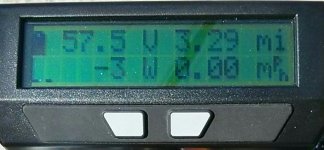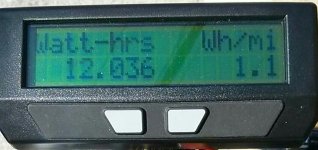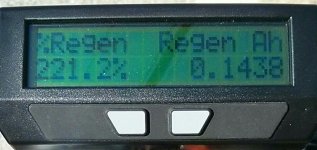My intention is to create a 44.4V 20Ah pack. 2 parallel, then 2 series for ease of use, charging and expansion. Although I am torn between expanding to 30Ah by going 3 parallel....
I run a 2S/2P Multistar 12S/20,000 mAh pack;
That's a 30 mile/plus range w/ moderate pedaling in the low 20's mph. Do you really need more range than that?
Desired max speed on level ground: >18mph. This is a commuter and "get healthy" build, not a speed machine.
Even using a low-speed motor(201 rpm @ 36 V rating), @ 12S LiPoly (45.6 V nom.) system will top out around 20 mph. That's just as well as 18 mph gets boring. Low 20's mph is the "sweet" spot, fast enough to be entertaining, but not so fast to get one in trouble. Remember, even a basic controller will have a 3-speed speed limiter.
Although I am torn between expanding to 30Ah by going 3 parallel, or going to 66.6V by putting another 2-pack in series
Not sure I understand where you are coming from on this one. First you state to you only want to go 18 mph, and here, you are talking about a very high Voltage system. It would change everything, certainly you would end up with a system way too fast for a hardtail. It will also add costs, for one thing, a 48V controller may not even handle that.
So looking at sub-$200 for the typical generic 750-1000W 48V front-wheel kit.
By that, I think you are referencing a direct drive 9C hub motor. Are you sure you want to put a Frisbee-sized motor on the frt. forks? Most of us who have built an "assist type" ebike use a smaller geared motor, way less weight swinging on the frt. end, stealthier, better free-wheeling and better performance on 36V/48V, especially climbing hills.
My very first build used a MXUS geared motor up frt.;

I put many 1,000's of miles on that bike and I certainly would not have wanted a heavier, more powerful motor. On 48 Volts, there were times when the tire would spin, like taking off on a slight uphill when the pavement was damp. The light 2.2 Kg motor balanced the small "rack" 10 Ah battery nicely and overall the bike handled well.
When I went to a larger LiPoly pack, I put them into a Triangle frame bag;
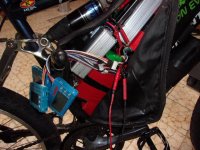
If one has an open triangle area, why not use it, handling will be much improved. The dedicated bag has been great, liteweight and durable, it's been money very well spent. Frankly, heavy, metal ammo boxes are better put to use storing batteries or in your case, adapting them as hard bags for your KLR.
Also plan on buying some XT90 connectors, MT60s (wheel phase connectors), MT30s (wheel sensors)
One of the advantages of a low-powered system is being able to use the easiest connectors and a light gauge wire. For me, the 4 milimeter bullet connectors are much easier to solder and plug and unplug. I use them for power wires and also on the phase wires. I use the high quality Turnigy's I get on Ebay. In the same vein, you will need 2 two into one adaptors for the 2P and although I make my own, the Hobbyking 14 Ga. ones work great. When I'm ordering them, I also order 14 ga. Turnigy silicone wire. @ 1000 Watts, nothing more is needed, but I sometimes use 12 Ga. on the final run from the pack to controller if it's long.
Also plan on buying some....... BMS low-voltage alarms, and a few 10AWG in-line fuse kits (fuse 20A slow-blow for each parallel set of 2 packs, then a 30A on the total).
If you match the 12S pack to a 48 V controller, a troublesome BMS is not needed. The controller w/ provide the LVC and a dedicated LVC eliminates the need for alarms which tend to be hard to set where they don't start beeping prematurely. Fuses are not needed either, If you shunt the pack wires together, a 4 m/m bullet will melt, certainly a fuse on each 2S run would be overkill.
And finally another +$50 or so for for a Mean Well CLG-150-48A for on-the-go charging. All it needs is the current turned down to minimum as 48V setting is pretty much where I want to go at 80%ish max charge on a 12S.
You are on the right track here, the huge advantage of bulk charging is not having to "break the string" to charge and by using large bricks and staying at 2P, you have set yourself to do it. I use the Mean Well GLH-320-54A and 4 of the high quality Battery Medics, here charging a 2S/1p pack;
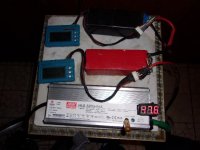
Bulk charging LiPoly is about as close to a "plug and play" system as one can get, but LiPoly requires a two-stage process, a storage charge to 3.90V and a top charge before going out. Top charging to 4.10V does no harm to the pack and w/ my MW it takes 20 to 30 minutes. A 150 Watt MW will take twice as long. The 80% discharge rule applies to the discharge end. Although my LVC w/ shut down @ 3.65V/cell, I try not to go below 3.75V. That's the advantage to a big pack, not having to go low.
When my MXUS geared mini finally "gave up the ghost", I switched to the popular Q100 CST (cassette version), also called the Cute;

It's a low-speed (201) motor that I run on 14S for a top speed of 23 mph and it's the best assist combo I have used to date. I just luv to way it hides behind the cassette/brk. disc. Although I prefer the motor to be rear mounted, a Q100H (260) mid-speed motor on 12S is a nice combo that will go to about 23 mph too. It can be frt. mounted since it is not a cassette motor and then the build will not need the expensive DPN free wheel(A free wheel w/ an 11t sm. gear is manatory and only the DNP has that).
Sorry if I seem critical of your plan, it's just, after 8 years and a half a dozen builds, I kinda have a handle on what works for an assist ebike, especially budget ones.







